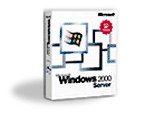Windows NT Advanced Server 3.1 was designed to serve as a dedicated server in a client/server environment.
Microsoft Windows server operating systems have a shorter history than Windows desktop operating systems, but they share the same legacy.
In 1988, Microsoft formed what would become the development team for Microsoft Windows NT®, with the goal of developing a full 32-bit, multipurpose operating system.
In 1991, at the Microsoft Windows Developers Conference, Microsoft demonstrated Windows Advanced Server for LAN Manager, a high-end operating system that would later be renamed Windows NT. The product offered the familiar Windows user interface and programming model, and was capable of running all the applications developed for Windows 3.0.
1993: Windows NT Advanced Server 3.1
At the same time Microsoft released the first desktop version of Windows NT in July 1993, it also released Microsoft's first Windows Server operating system. Windows NT Advanced Server 3.1 was designed to act as a dedicated server in a client/server environment, offering power, scalability, enhanced fault tolerance, and standards-based interoperability.
|
|
|
Microsoft promoted Windows NT Advanced Server as an application server for Novell NetWare, Banyan VINES, and Microsoft networks, capable of providing a platform for sophisticated business solutions such as financial, accounting, and vertical applications. As an application server, Windows NT Advanced Server was also a powerful platform for database servers such as Microsoft SQL Server™, communications servers such as Microsoft SNA Server, and mail servers such as Microsoft Mail.
For network management, Windows NT Advanced Server provided customers with centralized security and server management, along with graphical tools to manage multiple systems as well as a single logon for enterprise users.
As the first Windows Server operating system, Windows NT Advanced Server 3.1 combined the ease of use of Windows with the power of the first server operating system from Microsoft, LAN Manager.
1994: Windows NT Server 3.5
The next release of Windows NT Server was built on the stability of version 3.1, but with greatly enhanced processing speed and improved connectivity to other systems, particularly in Novell NetWare and UNIX environments.
Enhancements included new administration tools, improved client software configuration, an auto-reboot and dump facility, better tools for NetWare, and better remote access capabilities.
1995: Windows NT Server 3.51
This incremental release included a tool to help customers manage Client Access Licenses (CALs) for the Microsoft BackOffice® family of server products (now referred to as Microsoft .NET Enterprise Servers), a utility to enable over-the-network installation of Windows 95, and support for remote booting.
1996: Windows NT Server 4.0
With this upgrade, Windows NT Server became a full 32-bit operating system and gained the popular look and feel of Windows 95. Windows NT 4.0 also added many advanced features for business and technical users, including:
Subsequent service packs and option packs offered additional features, including public-key and certificate authority functionality, smart card support, improved symmetric multiprocessing (SMP) scalability, clustering capabilities, and component object model (COM) support.
1997: Windows NT Server 4.0, Enterprise Edition
Windows NT Server 4.0, Enterprise Edition built on the benefits of Windows NT Server 4.0 by adding features and capabilities designed to appeal to large corporate customers with mission-critical requirements. Windows NT Server 4.0, Enterprise Edition added greater performance and scalability, higher availability, and expanded services for developing enterprise applications.
The product also included Microsoft Transaction Server to facilitate the development of Internet and intranet applications, and Microsoft Message Queue Server (MSMQ), which enabled applications running at different times to communicate across heterogeneous networks and systems that may be temporarily offline.
Windows NT Server 4.0, Enterprise Edition also supported critical server resources with the Microsoft Cluster Service and Windows NT Server load balancing service, large SMP servers, and memory-intensive applications.
In October 1998, Microsoft announced that it would drop the "NT" suffix in the next major version of the Windows NT operating system, which would become known as Windows 2000.
1998: Windows NT Server 4.0, Terminal Server Edition
Windows NT Server 4.0, Terminal Server Edition gave the Windows NT Server operating system the capability to serve 32-bit Windows operating system-based applications to terminals and terminal emulators running on PC and non-PC desktops. The terminal server environment was, by definition, a thin-client architecture where all application processing occurred centrally on the server.
Because Terminal Server clients were available for many different desktop platforms, including Macintosh and UNIX, Terminal Server provided access to 32-bit Windows–based applications from virtually any desktop. Windows NT Server 4.0, Terminal Server Edition, offered a bridging technology for organizations that were transitioning to a pure 32-bit desktop environment, by allowing their existing non-Windows-based computers to connect to a Windows network.
Windows NT Server 4.0, Terminal Server Edition, consisted of three components:
2000: Windows 2000 Server Family
 Bill
Gates unveiled Microsoft's family of Windows 2000 client and server software
at an elaborate launch event in February 2000 that featured dozens of companies
demonstrating Windows 2000–compatible hardware and software.
Bill
Gates unveiled Microsoft's family of Windows 2000 client and server software
at an elaborate launch event in February 2000 that featured dozens of companies
demonstrating Windows 2000–compatible hardware and software.
Windows 2000 was released in both desktop (Windows 2000 Professional) and server versions. The desktop version has since been upgraded to Windows XP Professional, while the server versions of Windows 2000 will be upgraded when Microsoft releases Windows .NET Server.
The three server versions of Windows 2000 offer a wide range of features that provide the reliability, scalability, and manageability required by businesses of all sizes.
These operating systems offer a broad set of capabilities for Web developers, including a high-performance Web server featuring Active Server Pages (ASP), COM+ component services, transaction and message queuing support, and end-to-end XML support.
For IT professionals, the Windows 2000 Server family offers advanced features, centralized, policy-based management with new technologies such as Microsoft IntelliMirror® management technologies and the Microsoft Active Directory™ service, and faster deployment options that lower cost of ownership for organizations of all sizes.